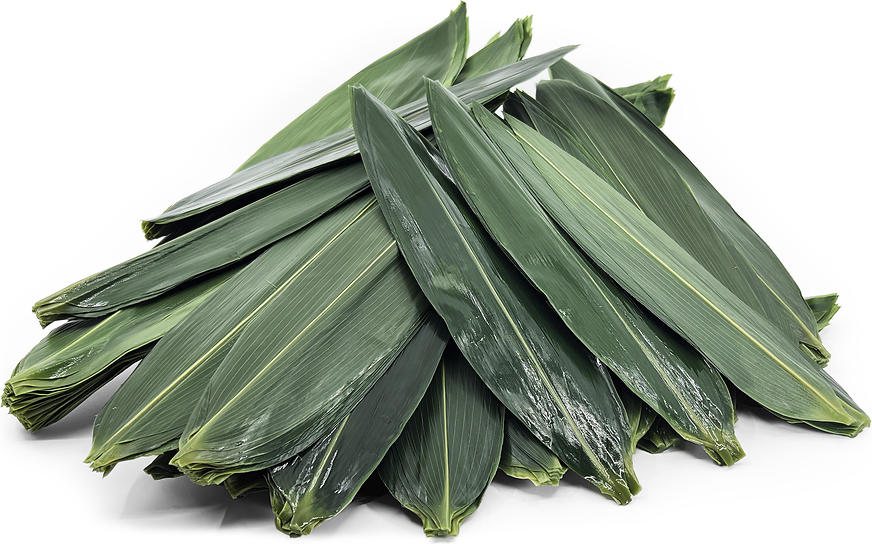


Leaves Bamboo (Sasaya)
Estimated Inventory, ea : 4.00
This item was last sold on : 07/10/25
Description/Taste
Bamboo leaves are medium to large in size and are long and lanceolate in shape tapering to a sight point opposite the stem end. The deep green leaves are tough, leathery, and smooth and are connected to green or brown stems that can grow up to ten centimeters a day. Typically, Bamboo leaves are harvested when they are no more than thirty centimeters in length and five centimeters in width, and they have a mild, sweet taste with faint notes of green tea.
Seasons/Availability
Bamboo leaves are available year-round.
Current Facts
Bamboo leaves grow on perennial evergreen plants that belong to the Poaceae or grass family, and there are over one thousand different Bamboo species. Bamboo leaves come from many different species, and the most common species hail from China including the Black Bamboo, Phyllostachys nigra, and Maozhu, Phyllostachys edulis. They are also found in Japan from a dwarf species known as Kumaizasa or Sasa senanensis. Also known as Sasaya or Sasa leaves, Bamboo leaves are extremely versatile and can be used medicinally, to preserve or flavor food, or dried and used in Bamboo leaf tea.
Nutritional Value
Bamboo leaves contain protein, amino acids, potassium, calcium, manganese, and iron. They also have a high polyphenol content and exhibit antioxidant and antibacterial effects.
Applications
Bamboo leaves are not consumed and are instead used as a wrapper or as a vessel for food. As a wrapper, the leaves are used for dishes such as glutinous rice dumplings known as Zongzi in China. The rice is stuffed with a filling like pork or mushrooms, wrapped in a Bamboo leaf, and then steamed as the leaf infuses the rice with a tea-like flavor. Bamboo leaves are also used for wrapping Sasazushi, a type of sushi, and these bite-sized packages may contain a mixture of vegetables and fish on top of rice. Bamboo leaves are commonly seen in sushi presentations, and many sushi restaurants will use real Bamboo leaves as a decorative piece in their bento boxes. It is rare to find fresh Bamboo leaves in stores as they are perishable and only last for a couple of days, but some specialty shops sell dried and pasteurized Bamboo leaves. When purchased fresh, Bamboo leaves should be immersed in water in a container and stored in the refrigerator where they will keep up to three days. Dried and pickled Bamboo leaves will keep up to one year.
Ethnic/Cultural Info
Bamboo leaves are frequently used in traditional Chinese medicine and instances of their use were recorded in pharmacopeias such as in The Truth Seeking Materia Medica of China by Huang Gongxiu, which dates back to the 1700s. Considered to be a cooling element to the body, Bamboo leaves are believed to be able to help reduce phlegm, fevers, and stomach upsets. The entire plant is also able to be used in the construction of home furnishings, crafts, bowls, and building materials, and the leaves are also used as animal feed in Japan and China.
Geography/History
The exact origins of Bamboo leaves are unknown, but the plants have been growing wild since ancient times. Today Bamboo leaves can be found at fresh local markets throughout East Asia in Japan, China, Korea, India, and Nepal and are also found in parts of Africa, Australia, South America, and the United States.
Featured Restaurants
Restaurants currently purchasing this product as an ingredient for their menu.
| Park Hyatt Aviara | Carlsbad CA | 760-448-1234 |
| Grass Skirt (Bar) | San Diego CA | 858-412-5237 |
| Lodge at Torrey Pines Main | San Diego CA | 858-453-4420 |
| Craft House Sky Deck | San Diego CA | 619-948-4458 |
| Nolita Hall - Bar | San Diego CA | 619-618-8820 |
| Hilton Mission Valley | San Diego CA | 619-543-9000 |
| Pacific Yacht Agents | Los Angeles CA | 808-214-0970 |
| Pendry SD (Pool House) | San Diego CA | 619-738-7000 |
| Waverly (Bar) | Cardiff CA | 619-244-0416 |
| Lauberge Del Mar | Del Mar CA | 858-259-1515 |
| Botanica | San Diego CA | 619-310-6320 |
| Sago (Bar) | Encinitas CA | 858-382-4047 |
| Craft House Fashion Valley | San Diego CA | 619-948-4458 |
| El Sueno (TAKO) | San Diego CA | 619-972-6286 |
| WaterBar | San Diego CA | 619-308-6500 |
| Savory Moment (1) | Carlsbad CA | 619-633-8863 |
Recipe Ideas
Recipes that include Leaves Bamboo (Sasaya). One




